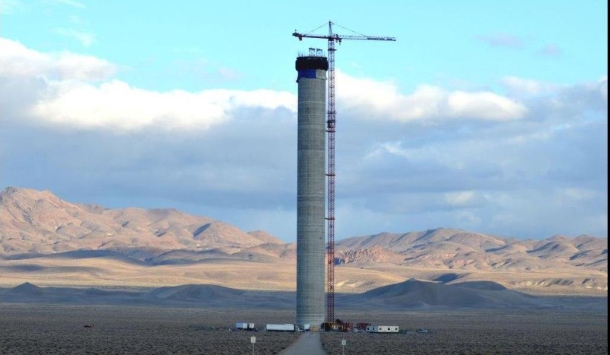
Solar tower will power Las Vegas at night
SolarReserve has completed the central point of a solar project that uses molten salt storage to deliver power to the grid well after the sun has gone down.
The startup company today said it has completed the 540-foot tower of the Crescent Dunes Solar Energy Project near Tonopah, Nev., which is expected to start delivering 110 megawatts by the end of 2013. When it comes online, it’s projected to have 10 hours of storage, the longest full-load storage capacity for a solar plant.
Adding storage turns solar into a continuous power source and allows project developers to earn more money for their electricity. As a result, solar projects that use heat to make electricity have added molten salt storage to their facilities.

SolarReserve’s technology is different than traditional molten salt storage systems in that all electricity is generated from storage and there is only one working fluid–salt, heated to about 1,000 degrees.
In the summer, the Crescent Dunes project’s general contractor intends to start installing a field of 10,000 billboard-size sun-tracking mirrors called heliostats around the tower. Sunlight is reflected onto a 100-foot receiver which house a series of tubes of circulating salt. The heliostat field will be about two miles across.
Salt stored in a tank at 500 degrees is pumped up from the base and heated up. Then the salt is circulated down into another storage tank. When the utility calls for power, the hot salt goes through another heat exchanger on the ground to make steam which drives a traditional electricity turbine.
Utility NV Energy expects to be drawing on the power plant between noon and until 10 p.m. or midnight since the bulk of its load is Las Vegas, said SolarReserve CEO Kevin Smith.
That steady operation through storage results in more energy produced over the course of a year compared to solar photovoltaic projects with the same power rating. The 110-megawatt Crescent Dunes project will produce about 500,000 megawatt-hours per year. A solar photovoltaic project with 110 megawatts capable of peak output would produce less than half the energy on a yearly basis, Smith said.
Funding for this size of project is significant. SolarReserve raised $260 in private equity and $737 million in debt from the Department of Energy’s Loan Guarantee program.
The company is already working on other projects, including larger ones in the Middle East, Smith said. But the primary challenge, apart from completing this project, is bringing the cost of electricity down. With the plunge in solar panel prices, a few large-scale solar projects have scrapped solar thermal technologies for photovoltaics.
The cost for energy from this plant is projected to be 13.5 cents per kilowatt-hour and will go up 1 percent a year during its 25-year power purchase agreement. That’s cheaper than a new nuclear power plant or a coal plant with carbon capture and storage, but more expensive than a new natural gas plant, Smith said
“This technology has been well proven. (But) this is project No. 1, so it’s like a hand-crafted large-scale project,” he said. “The key for future projects is to make improvements on the pricing.”
(Source)
